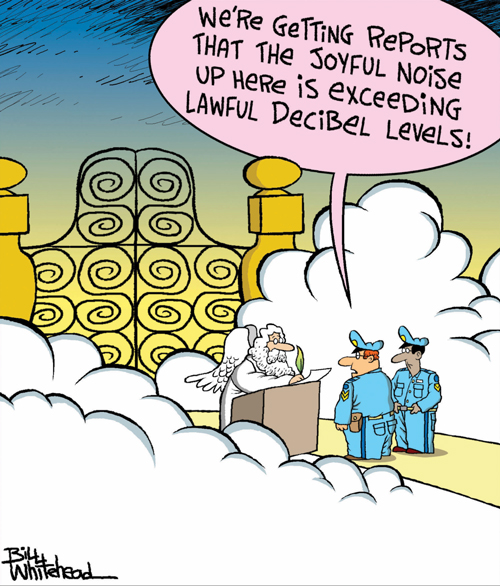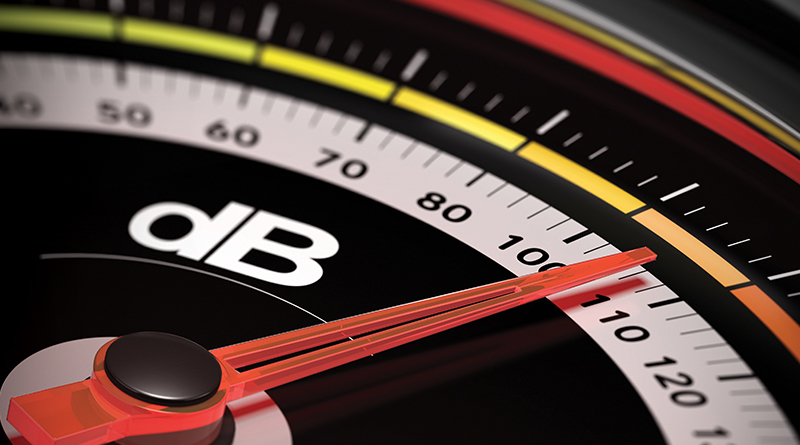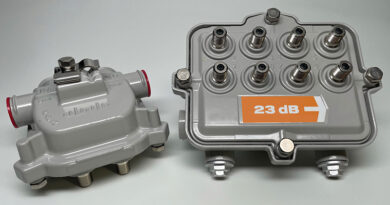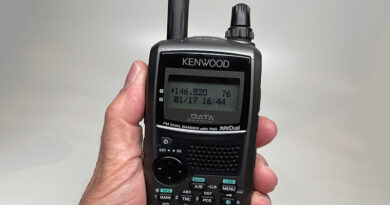The Wise and Mighty Decibel
By Ron Hranac
The decibel plays a major role in the world of test and measurement. Simply put, the decibel — abbreviated dB — is used to express the ratio of two power levels. That’s it. The following is a more formal definition, included in two of SCTE’s operational practices1: “A logarithmic-based expression of the ratio between two values of a physical quantity, typically power or intensity. The decibel provides an efficient way to express ratios which span one or more powers of the logarithmic base, most commonly 10. Mathematically, the ratio of two power levels P1 and P2 in decibels is dB = 10log(P1/P2).”
It’s All About the Ratios
Here’s an example. Let’s say you have a 100 watt stereo and your neighbor has a 200 watt stereo. How much more powerful, in dB, is your neighbor’s stereo than yours? Grab your scientific calculator and plug the two stereo systems’ power levels into the previous formula (I added a subscripted 10 after “log” to show that we’re dealing with base-10 logarithms).
dB = 10log10(P1/P2)
dB = 10 x [log10(P1/P2)]
dB = 10 x [log10 (200/100)]
dB = 10 x [log10 (2)]
dB = 10 x [0.301]
dB = 3.01
From this, your neighbor’s stereo is 3.01 dB more powerful than your stereo. Here’s another example. If a local FM radio station gets a new transmitter that increases its output power from 20,000 watts to 40,000 watts, how much more powerful, in dB, is the new transmitter than the old one? As before, the answer can be found with the aforementioned formula:
dB = 10 x [log10 (40,000/20,000)]
dB = 10 x [log10 (2)]
dB = 10 x [0.301]
dB = 3.01
In both cases the answer is about 3 dB. How’s that possible? In the first example the power difference is 100 watts, and in the second example the power difference is 20,000 watts! Why does 3 dB apply to both examples? The absolute difference between the two power levels isn’t what matters, it’s the ratio of the two power levels. In both examples the ratio is 2 (one power level is twice as much as the other). The relationship works in the other direction, too. If one power level is half as much as another, or a given power level is reduced by half, the difference is 3 dB. It doesn’t really matter what the actual levels are, just the ratio between them.
Attenuation
The decibel can be used to express attenuation in coax and passive devices such as splitters, directional couplers, connectors, pads, equalizers, filters, etc. For instance, a two-way splitter is a power divider, which evenly divides the RF power at the splitter’s input port between its two output ports: half of the original input power is present at each output port. That’s why we say a two-way splitter has about 3 dB of loss (it’s actually around 3.5 to 4 dB, because of additional minor losses and inefficiencies in internal components).
The theoretical loss in decibels of a perfect splitter with “N” number of output ports is calculated using the formula LdB = 10log10(N). This formula assumes that the input power is equally divided among the output ports. A two-way splitter’s loss per port is
LdB = 10log10(2)
LdB = 10 x [log10(2)]
LdB = 10 x [0.301]
LdB = 3.01
A balanced three-way splitter’s loss is 4.77 dB, a four-way splitter’s loss is 6.02 dB, an eight-way’s loss is 9.03 dB and so on. Don’t forget about the slight additional loss above and beyond the calculated values.
Gain
In addition to loss, the decibel is used to express gain in active devices. If a drop amp has 10 dB of gain, that means the output power is 10 times the input power; if it has 20 dB of gain, the output power is 100 times the input power. 30 dB of gain and the output power is 1000 times the input power.
Indeed, the decibel is quite versatile. It’s also used for measurements such as return loss (see the Spring 2017 issue of Broadband Library at Broadband Library.com), carrier-to-noise ratio, carrier-to-distortion ratio, signal-to-noise ratio, and modulation error ratio. As before, the decibel is being used to express the ratio of one value to some other value.
Signal Level
What about signal level, also known as RF power? The decibel by itself cannot be used to express signal level. It’s flat out wrong to say something like “the amplifier’s output is 45 dB” or “the input to the modem is –2 dB.” To correctly express signal level using the decibel, a reference has to be appended, as in decibel millivolt (dBmV).
The definition of dBmV is “decibels relative to 1 millivolt (mV),” which allows the decibel to be used to indirectly state absolute values. Why indirectly? A metric such as dBmV still represents a ratio. In this case the ratio is some value to a “0 dB” reference, where 0 dBmV equals the previously mentioned 1 mV in a 75-ohm impedance. When we say an amplifier’s RF output is 45 dBmV, the level is 45 dB greater than 1 mV (or 45 dB greater than 13.33 nanowatts; more on how the latter is calculated in a moment). Likewise, if the input to a modem is –2 dBmV, the level is 2 dB less than 1 mV (or 2 dB less than 13.33 nW). The formula for decibel millivolt is dBmV = 20log10 (level in millivolts/1 millivolt).
You might be wondering how dBmV, in which the appended reference is a voltage, can be used for RF power (and where did that “20” come from in the previous formula?). The following explanation is a footnote to the earlier definition of decibel, included in the previously mentioned SCTE operational practices.
“The decibel, while technically a ratio of two power levels, also can be used to represent the ratio of two voltage levels, assuming the two voltages are across the same impedance. Here is how that relationship is derived: The unit of electrical power, the watt, equals 1 volt multiplied by 1 ampere. Equation-wise P = EI, where P is power in watts, E is voltage in volts, and I is current in amperes. Substituting the Ohm’s Law equivalent for E and I gives additional formulas for power: P = E2/R and P = I2R. If the right hand side of the power equation P = E2/R is substituted for both P1 and P2 in the formula dB = 10log(P1/P2), the equation becomes dB = 10log[(E2/R)/(E2/R)] which is the same as dB = 10log[(E12)/R1)/(E22/R2)]. In this example, R represents the 75 ohm impedance of a cable network. Since R1 and R2 are both equal to 75 ohms, those equation terms cancel, leaving the equation dB = 10log(E12/E22). This can be simplified somewhat and written as dB = 10log(E1/E2)2 which is the same as dB = 2 * 10log(E1/E2) or dB = 20log(E1/E2).”
How does one get 13.33 nW from dBmV’s 0 dB reference of 1 mV? Here’s the math, using the formula P = E2/R, where P is power in watts, E is voltage in volts (1 mV or 0.001 volt) and R is the cable network’s 75 ohm impedance.
P = 0.0012/75
P = 0.000001/75
P = 0.00000001333 watt, or 13.33 nW
From this, we see that dBmV expresses power in terms of voltage. 0 dBmV defines the power produced when a root mean square voltage of 1 mV is applied across a defined impedance, which is 75 ohms in the case of the cable industry. That is, 1 mV in a 75 ohm impedance is 13.33 nW, which we call 0 dBmV.
When Things Change
It can be a bit tricky when stating changes in decibel values, especially if dBmV is thrown into the mix. Over the years I’ve seen and heard many instances of statements along the lines of “The signal level at the modem input increased by 2 dBmV, going from +3 dBmV to +5 dBmV.” This kind of statement is incorrect, because signal levels cannot increase or decrease in increments of dBmV, only dB.
Here’s a closer look at why. First, convert 2 dBmV to millivolts using the formula mV = 10(dBmV/20).
mV = 10(2/20)
mV = 10(0.10)
mV = 1.26
The math says 2 dBmV is equal to 1.26 mV. Using the same formula 3 dBmV works out to 1.41 mV, and 5 dBmV is 1.78 mV. The signal level increase in the previous example was from 3 dBmV (1.41 mV) to 5 dBmV (1.78 dBmV), which is only 0.37 mV difference, not 1.26 mV. What should have been said is “The signal level at the modem input increased by 2 dB, going from +3 dBmV to +5 dBmV.”
Here’s another example. Assume you measure the output of an amplifier, and find that Ch. 2’s level is 40 dBmV and Ch. 117’s level is 48 dBmV. Is the tilt 8 dBmV or 8 dB? The difference between 48 dBmV and 40 dBmV is 8 dB, because 48 dBmV– 8 dB = 40 dBmV (or 40 dBmV + 8 dB = 48 dBmV).
As you can see, it’s simple addition or subtraction, but the value to be added or subtracted must be in dB, not dBmV.
Power Addition and Total Power
 Another topic that can be confusing is RF power addition, especially as it relates to total power. Total power is the combined power of all signals in a given frequency range — for instance, the downstream. It’s of concern because excessive total power is what overdrives lasers, set-tops, modems, and other devices. Calculating total power is straightforward if all of the individual signals have the same power or level. A quick back-of-napkin power addition approach works like this. Assume your cable network has just one channel, and its power is 0 dBmV. The total power also is 0 dBmV (remember, 0 dBmV is equal to 13.33 nW; the “0” doesn’t mean “no power”). Double the number of channels to two, each at 0 dBmV, and the total power increases to 3 dBmV (actually 3.01 dBmV). Double the number of channels to four, each at 0 dBmV, and the total power increases to 6 dBmV. Double the count to eight, with each channel at 0 dBmV, and now the total power is 9 dBmV. And so on. Each time the number of equal-power channels doubles, the total power also doubles, or goes up by about 3 dB.
Another topic that can be confusing is RF power addition, especially as it relates to total power. Total power is the combined power of all signals in a given frequency range — for instance, the downstream. It’s of concern because excessive total power is what overdrives lasers, set-tops, modems, and other devices. Calculating total power is straightforward if all of the individual signals have the same power or level. A quick back-of-napkin power addition approach works like this. Assume your cable network has just one channel, and its power is 0 dBmV. The total power also is 0 dBmV (remember, 0 dBmV is equal to 13.33 nW; the “0” doesn’t mean “no power”). Double the number of channels to two, each at 0 dBmV, and the total power increases to 3 dBmV (actually 3.01 dBmV). Double the number of channels to four, each at 0 dBmV, and the total power increases to 6 dBmV. Double the count to eight, with each channel at 0 dBmV, and now the total power is 9 dBmV. And so on. Each time the number of equal-power channels doubles, the total power also doubles, or goes up by about 3 dB.
Power addition can also be sorted out with the formula Ptotal = Pone + 10log10(N), where Ptotal is total power in dBmV, Pone is the power of one channel in dBmV, and N is the number of channels (as before, the assumption is that all signals have equal power). If there are 117 channels, and the power of each one is 3 dBmV, the total power is
Ptotal = 3 + 10log10(117)
Ptotal = 3 + 10 x [log10(117)]
Ptotal = 3 + 10 x [2.07]
Ptotal = 3 + 20.68
Ptotal = 23.68 dBmV
If the power of each channel is different, a more typical situation, total power is calculated with the formula Ptotal = 10log10[10(P1/10) + 10(P2/10) + 10(P3/10) + … + 10(PN/10)], where Ptotal is total power in dBmV, and P1, P2, P3…PN are the levels of each channel in dBmV.
Related to total power is the per-channel power decrease as the number of transmitted channels per port of a modem or quadrature amplitude modulation (QAM) modulator increases. For example, if a QAM modulator’s maximum RF output power is 60 dBmV in one-channel mode, the per-channel power will theoretically drop 3.01 dB to 56.99 dBmV when two channels are transmitted (in practice the per-channel power decrease will be about 4 dB to 56 dBmV). For four channels, the per-channel level will drop another 4 dB to 52 dBmV, and so on. In order for the modulator’s maximum total power to remain at 60 dBmV, the per-channel power has to drop as the number of channels increases.
Wrapping Up
The key takeaways to remember are that the decibel is a logarithmic-based way to express the ratio of two power levels; it can be used for the ratio of two voltage levels as long as both are in the same impedance. Decibels are also used to express gain and loss, but dB by itself cannot be used for stating signal levels. For that, one needs to append a reference, as in dBmV. Changes in decibel-related values are done by adding or subtracting dB, not dBmV. Finally, power addition and total power are yet other important applications of the decibel. Class dismissed!
 Ron Hranac
Ron Hranac
Technical Leader,
Cisco Systems
Ron Hranac, a 44-year veteran of the cable industry, is Technical Leader for Cisco’s Cable Access Business Unit. A Fellow Member of SCTE, Ron was inducted into the Society’s Hall of Fame in 2010, is a co-recipient of the Chairman’s Award, an SCTE Member of the Year, and is a member of the Cable TV Pioneers Class of ’97. He received the Society’s Excellence in Standards award at Cable-Tec Expo 2016. He has published hundreds of articles and papers, and has been a speaker at numerous international, national, regional, and local conferences and seminars.
Credit: Cartoonstock.com
Credit: Shutterstock.com





